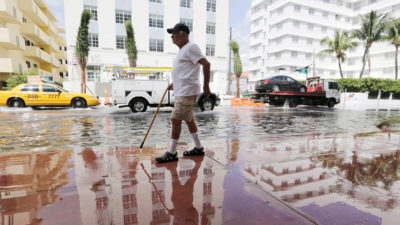The sun’s out, and Miami is flooding without a drop falling from the sky. Why? Due to Miami’s low elevation and porous limestone geology, water wells up from the ground when the water table rises. An average spring rain paralyzes the region with flooded roads, cars, and buildings. Alarmingly, this is becoming a more frequent reality for Miamians.

Image credit: Yale 360. Retrieved from: https://e360.yale.edu/features/who-will-pay-for-the-huge-costs-of-holding-back-rising-seas
What’s causing that rise in groundwater? The swelling ocean. Most people think of “flooding” as “storm surge”, where ocean waves crash into our city during storms. But that’s not the only kind of flooding that Miami is facing, and projects designed to keep Miami dry should consider other kinds of water-based impacts. As tides get higher and higher, groundwater near the coast also rises -- with water coming up from below our feet. By now, Miamians are familiar with water surfacing through storm drains and with puddles that stay ponded in low-lying coastal areas.

This graphic illustrates the relationship between sea level and groundwater level. Image credit: Miami Waterkeeper Files
This is why it’s so important to address “compound flooding”. Just as the term suggests, this happens when two or more types of floodwaters merge and swell. Adding a consideration of rising groundwater to storm surge and rainfall will yield more holistic and effective solutions to protect Miami.
What can be done? State, local, and federal agencies need to study water from all directions as they propose solutions for near-future flood risks. For instance, if the Army Corps is going to analyze the effects of flooding in our city from storm surge, it should also acknowledge and integrate efforts to address rising groundwater and increased precipitation from storms that move more slowly and hover over our city, as climate models predict. This will not be easy nor cheap, but planners need to consider compound flooding early in the design phase, we can't stress this enough. Learn more from our partners at Environmental Defense Fund here in their excellent blog on comprehensive flood risk management.
Image credit: University of Texas. Retrieved from https://sites.utexas.edu/climatesecurity/2020/03/25/flooding-from-all-directions-how-compound-flooding-threatens-urban-areas-in-oceania/






